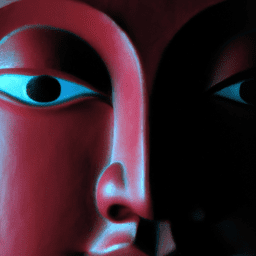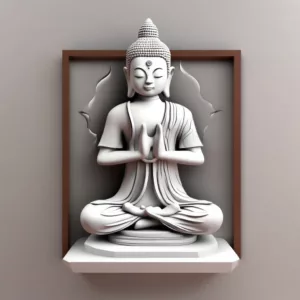9 Stages of Resting the Mind, Part 5
Samadhi Meditation in Buddhism means the state of fully attained meditation. Focus is unwavering, body is still, thoughts are non-occurring. The object is stable, clear, and powerfully present in the mainstream. Samadhi is genuine mental peace.
| 3 Areas | 6 Powers | 9 Stages | 5 Obstacles | 8 Antidotes | 3 Qualities | Experience |
|---|---|---|---|---|---|---|
| Hearing/ contemplating | 1: Placecement | Laziness Forgetting the instructions | Faith Aspiration Exertion Shinjang | Stability | Movement/ Waterfall |
|
| Preparation | 2: Continuous placement | |||||
| 3: Repeated Placement | Elation & Dullness | |||||
| Actual Meditation | Mindfulness Introspection/ Awareness | 4: Close Placement | Introspection / Awareness | Clarity | Attainment / Brook | |
| 5: Taming | Familiarity Slow River |
|||||
| 6: Pacifying | Power / Strength | |||||
| Exertion | 7: Thoroughly pacifying | Not applying antidotes | Applying antidotes | Stability / Calm Lake | ||
| Increasing Meditation | 8: One-pointedness | Overapplying antidotes | Resting in Equanimity | |||
| Thorough Familiarity | 9: Equanimity | Perfection/Mountain |
Table of Contents
Samadhi Meditation

Samadhi meaning: unification of the mind, or ‘bring together.’ It refers to the highest levels of attainment on the meditative path, at least while the being still has a physical body.
Samadhi Meditate PDF
Stage 4 of Samadhi Meditation: Close Placement
Approaching true samadhi meditation: at this point, we are in the fourth stage. This is a huge change. Some teachers would say this is when actual meditation begins because the mind never strays from the object of meditation. It’s not deeply penetrated into it. It has not attained a level of real clarity and power. It’s still a bit vague, and a bit fuzzy, but it’s not wandering off into thoughts.
Thoughts can be vaguely distracting, but it never completely leaves the object. The mind always knows what it is doing. It never forgets the instructions completely. This is called attainment because we have attained the goal of not wandering. Every time we sit down to meditate, there it is.
It’s also important to remember that one can attain the fourth stage and later, through not practicing for a long period of time, lose it again. However, it would be much easier to re-attain it the next time by doing some study and diligently meditating for a few days to a week of strong practice, understanding the nine stages and the aspects that come into play, going over it in one’s mind, developing good motivation and clarity, and having strong effort.
Dullness, sleepiness, or Lethargy, the Main Obstacle to Samadhi Meditation
The mind can be brought to the fourth stage again rather quickly, having attained it once. In the fourth stage, the primary obstacle is called dullness, laxity, or lethargy. There are coarse and subtle versions of this. The coarse version would be almost falling asleep in meditation or a sense of deep heaviness and thickness. This coarse dullness tends to be the primary obstacle in the fourth stage.
The mind is still on the object, but it’s almost overwhelmed by the sense of thickness. This stage is very difficult. This can create a painfulness in the meditation because it’s so clear that the mind is still on the object, but this sense of heaviness is so challenging.
The main instruction is awareness, the sheshin, seeing the dullness, seeing the heaviness. Many other antidotes can be applied:
- Standing and shaking it off
- Physical movement
- Body rub
- Deep out-breath to release the heaviness or dullness
- Meditating on dullness directly to see its substantiality
- Investigate the lightness of the mind, just loosening it up in any way you can.
- Learn to sleep (briefly) while sitting up
- Meditate on the process of falling asleep
- Key Point: Don’t Fight it. This makes the experience unpleasant and makes the mind averse to meditation.
Getting in a fight with your own mind in your meditation will cause meditation to 1) degrade rapidly and 2) feel very unpleasant. If this laxity comes and it’s regarded as some sort of terrible enemy, then meditation will become a chore. It’s important to accept that this obstacle is here and it needs to be simply worked with in a skillful manner, needs to be accepted and then balanced so that it doesn’t overwhelm.
The obstacle to meditation is the object of meditation
Nor is it helpful to push lethargy away by churning up the opposite. Gently and subtly put energy into the meditation, strengthening and empowering the meditation and focusing. When the laxity is gone, clarity will begin to establish itself. At first, we have stability, the mind is not wandering, but gently bringing up the clarity, the details of the object, the vividness of it, this will counter the coarse laxity. This is one of the best techniques.
5th stage of Samadhi Meditation: Taming
Obviously noticing it with the awareness and strengthening the mindfulness, giving a sense of vividness to it is the opposite of the laxity. Having largely overcome the coarse lethargy and dullness and having attained the stability we move on to the fifth stage of taming. This is when we’re dealing with the subtle version of dullness or laxity. The object and the mind are slightly separated, not quite integrated in the meditation.
Generally, the fourth stage is called actual meditation. At the fifth stage, there’s still a slight dislike of meditation. The meditator isn’t fully engaged with it. The subtle laxity is a huge obstacle mainly because it’s so difficult to spot. It’s almost a sense of satisfaction of having arrived. It’s a profound feeling, the state of subtle laxity in meditation.
Having not attained the fifth stage before, it may feel like the full attainment of the ninth stage, but it isn’t. It’s very important to parse the mind very clearly and subtly. Are there still thoughts going on in the background? Are they exerting any pull over the mind?
Use the awareness – the sheshin – to notice those subtle distracting thoughts. Is the meditation not quite vibrant? Does it lack power and really a sharp one-pointedness? Where is the object of meditation in relation to the concentration? Is it definitively integrated, or is there a sense of separation between them?
Examine the quality of the meditation itself, then rest openly. Alternate these two to deepen meditation.
Does the meditation have more the quality of a moving, gently bubbling brook, a steadily moving river, or is it oceanic? Is it vast and deep and extremely stable? Is it vivid and clear? It’s important to be honest with oneself, and then this stage can be worked through and moved through. If we’re not so satisfied with our meditation, if we realize it’s still beginning, then it can be deepened quite a bit from here. In the 5th stage, we’re taming the mind’s subtle laxity.
Stage 6 of Samadhi Meditation: Pacifying
In the sixth stage, we’re pacifying the subtle levels of emotion. There is some subtle laxity here, and also subtle elation. The coarse elation happened more in stages 2 and 3 when the mind was constantly moving off to objects of desire, getting excited about things that have nothing to do with meditation.
The small discursivenesses are easy to pacify and release, but hard to spot. The mind has a lot of skill and pliancy in relating to itself. At this stage, the experience is called familiarity. It’s said to be like a deep, steady river moving along. In the sixth stage, the mind begins to turn to a different object of meditation. Meditating on the breath, meaning the body in a sense, is too unstable. It’s too changeable, too inconstant to carry one all the way to the ninth stage. The mind will tend to shift itself to directly meditating on its own characteristics, on its own consciousness.
Stage 7 Samadhi Meditation: Thoroughly Pacifying
The meditative object may be a visualized form at this point. In the seventh stage, there’s a sense of victory that is happening. We’re aware we’ve not yet arrived fully, but we have essentially won the battle of meditation. It’s simply marching to the palace gates of equanimity.
The mind is becoming very skilled at balancing with trying to get too intense on the object of meditation, withdrawing completely into itself and thus creating a barrier with the object in the fifth and somewhat sixth stages. It is no longer too loose, going out and not being strong at all as happens in the second, third, and fourth stages.
In the seventh stage, strong undercurrents of very subtle thoughts and very subtle emotions need to be dealt with. It’s very easy to sort of just settle in here and think, “Well, this is it. This is all I need,” but this is a mistake. Because the mind has become so pliant and so capable and so able to work with itself, it’s very important and very useful to continue. The technique of that is the power of exertion or effort.
When meditation is really good: maintain diligence without becoming tight.
We make an intention to continuously exert ourselves without letting go. We do it. We bring it to the present moment without getting disturbed by it and know that we are going to attain the ninth stage. We redouble that effort. We do not destabilize the meditation but let it be relaxed and more and more powerful.
The obstacle here is subtle elation. This elation is very much focused on the meditation itself. The mind becomes overly excited at the prospect of continually improving the meditation and using it for the purpose of the path. Strengthening the visualization, increasing the felt presence of the form (deity usually), purifying, etc. This excessive excitement can destabilize the meditation by increasing the energy beyond the point the mind can handle.
Some people have psychotic breaks from meditation. It’s a real problem and I’ve known multiple people who experienced this issue. Most were later fine, but it was terribly unpleasant for them and their loved ones. In my opinion, these breaks are caused by a few factors, but an excessive amount of energy poured into the meditation is a primary one.
See this for more on the dangers of meditation.
8th Stage: One-Pointedness
The eighth stage is one-pointedness. The mind has attained the three powers of stability, clarity, and power. Meditation is flowing and is almost effortless. The mind is very calm, settled, and extremely stable. At the eighth stage, it’s important to really sharpen awareness and to see the most subtle levels. The obstacle here is failing to apply the antidotes to clear up these last bits so that we can enter the final stage of full equanimity.
You still need to apply those previous antidotes, even the first antidotes. Bring up some faith, aspiration, exertion, and shinjang. Bring up the mindfulness and remind yourself in very subtle and quick ways, to do those basic things. Bring up the awareness, so reapply all the antidotes.
The meditator should be very skillful at this point so the antidotes can effortlessly be applied in the most subtle manner. And of course, the sheshin, the awareness, is the key to them. It has to become very refined to see these most subtle levels of discursiveness and subtle distractions that are going on in the mind at this point.
9th stage: Equanimity
Having handled those subtle issues, we are at the ninth stage, but we’re at the beginning of the ninth stage, we haven’t gone to the end of the ninth stage. At this point meditation is nearing perfection – it is almost flawless. Equanimity, the holy grail of meditation, is in your hands.
Simply thinking of meditation we enter profound samadhi, directly focused on the object, without any obstacles, without any distractions at all, not even the subtlest levels. One obstacle still exists, however.
The mind is incredibly refined now, but it’s still applying the antidotes as it was in the eighth stage. Those are no longer needed, so they create their own subtle level of discursiveness and they must be released as well. Then the mind can enter perfect equanimity where it can meditate literally forever. At this point, the mind can meditate without stopping at all.
How long does it take? Some people have said the ninth stage takes three or four years to accomplish. Other teachers have said it can happen in as little as six weeks if a person is determined and practicing long, long periods each day.
As you get to the third, and fourth stages, the meditation periods naturally become longer and there would be seven to eight hours of practice in a day. And as you get towards the seventh and eighth stages, meditation begins to become more continuous. At any rate, the second and third stages can probably be accomplished in daily practice once you work up to an hour or more a day. The fourth stage would take somewhat longer. Pretty much beyond that is going to require some retreat practice to deepen and intensify the practice and leave behind the ordinary distractions of the world.
Conclusion: 9 Stages of Resting the Mind
The 9 stages of resting the mind are the Buddha’s most pertinent and useful teachings on attaining high levels of meditation. By studying the various factors: powers, stages, obstacles, antidotes, and so forth, it is possible to make strong progress fairly rapidly.
Effort is necessary, of course. You must maintain diligent daily practice and enter into retreats of at least 10 days to progress much past the 4th stage. However, many people have done it, so you can too!
Good luck.
faq
How to achieve samadhi?
To achieve samadhi or attain samadhi, follow the 9 stages of meditation as explained by the Buddha. First, know what meditation is, then, critically, learn to place the attention on the object. Learn how to maintain and extend that attention.
Is Samadhi Dangerous?
Samadhi is not dangerous if handled properly. Maintain a sense of relaxation and letting go and it will not cause any problems.
How can I Practice Samadhi Meditation?
You can practice samadhi meditation by studying and applying the 9 stages of mind training and the 4 foundations of mindfulness.
What does Samadhi Feel Like?
Samadhi feels like total unwavering focus. It is powerful, settled, and peaceful simultaneously.

May all beings be happy
May all beings be peaceful
May all beings be safe
May all beings awaken to the light of their true nature
May all beings be free








